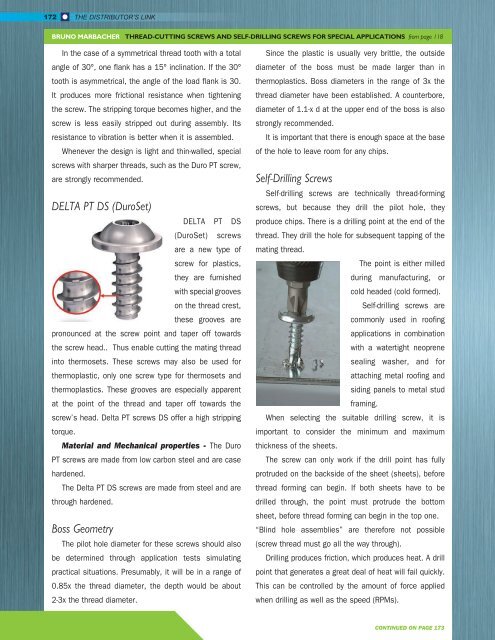FALL 2023
Distributor's Link Magazine Fall 2023 / Vol 46 No 4
Distributor's Link Magazine Fall 2023 / Vol 46 No 4
You also want an ePaper? Increase the reach of your titles
YUMPU automatically turns print PDFs into web optimized ePapers that Google loves.
172<br />
THE DISTRIBUTOR’S LINK<br />
BRUNO MARBACHER THREAD-CUTTING SCREWS AND SELF-DRILLING SCREWS FOR SPECIAL APPLICATIONS from page 118<br />
In the case of a symmetrical thread tooth with a total<br />
angle of 30°, one flank has a 15° inclination. If the 30°<br />
tooth is asymmetrical, the angle of the load flank is 30.<br />
It produces more frictional resistance when tightening<br />
the screw. The stripping torque becomes higher, and the<br />
screw is less easily stripped out during assembly. Its<br />
resistance to vibration is better when it is assembled.<br />
Whenever the design is light and thin-walled, special<br />
screws with sharper threads, such as the Duro PT screw,<br />
are strongly recommended.<br />
DELTA PT DS (DuroSet)<br />
DELTA PT DS<br />
(DuroSet) screws<br />
are a new type of<br />
screw for plastics,<br />
they are furnished<br />
with special grooves<br />
on the thread crest,<br />
these grooves are<br />
pronounced at the screw point and taper off towards<br />
the screw head.. Thus enable cutting the mating thread<br />
into thermosets. These screws may also be used for<br />
thermoplastic, only one screw type for thermosets and<br />
thermoplastics. These grooves are especially apparent<br />
at the point of the thread and taper off towards the<br />
screw’s head. Delta PT screws DS offer a high stripping<br />
torque.<br />
Material and Mechanical properties - The Duro<br />
PT screws are made from low carbon steel and are case<br />
hardened.<br />
The Delta PT DS screws are made from steel and are<br />
through hardened.<br />
Boss Geometry<br />
The pilot hole diameter for these screws should also<br />
be determined through application tests simulating<br />
practical situations. Presumably, it will be in a range of<br />
0.85x the thread diameter, the depth would be about<br />
2-3x the thread diameter.<br />
Since the plastic is usually very brittle, the outside<br />
diameter of the boss must be made larger than in<br />
thermoplastics. Boss diameters in the range of 3x the<br />
thread diameter have been established. A counterbore,<br />
diameter of 1.1-x d at the upper end of the boss is also<br />
strongly recommended.<br />
It is important that there is enough space at the base<br />
of the hole to leave room for any chips.<br />
Self-Drilling Screws<br />
Self-drilling screws are technically thread-forming<br />
screws, but because they drill the pilot hole, they<br />
produce chips. There is a drilling point at the end of the<br />
thread. They drill the hole for subsequent tapping of the<br />
mating thread.<br />
The point is either milled<br />
during manufacturing, or<br />
cold headed (cold formed).<br />
Self-drilling screws are<br />
commonly used in roofing<br />
applications in combination<br />
with a watertight neoprene<br />
sealing washer, and for<br />
attaching metal roofing and<br />
siding panels to metal stud<br />
framing.<br />
When selecting the suitable drilling screw, it is<br />
important to consider the minimum and maximum<br />
thickness of the sheets.<br />
The screw can only work if the drill point has fully<br />
protruded on the backside of the sheet (sheets), before<br />
thread forming can begin. If both sheets have to be<br />
drilled through, the point must protrude the bottom<br />
sheet, before thread forming can begin in the top one.<br />
“Blind hole assemblies” are therefore not possible<br />
(screw thread must go all the way through).<br />
Drilling produces friction, which produces heat. A drill<br />
point that generates a great deal of heat will fail quickly.<br />
This can be controlled by the amount of force applied<br />
when drilling as well as the speed (RPMs).<br />
CONTINUED ON PAGE 173
















